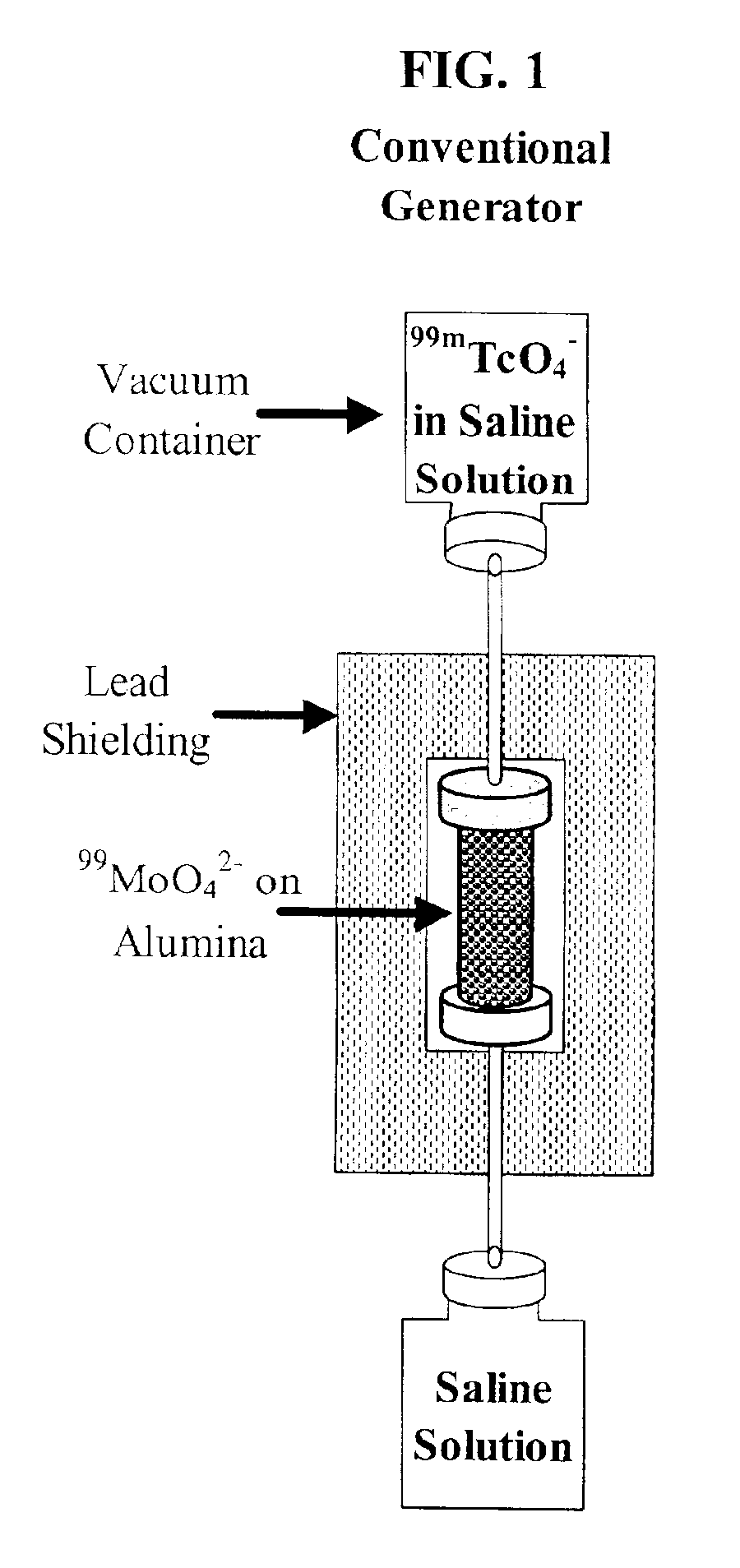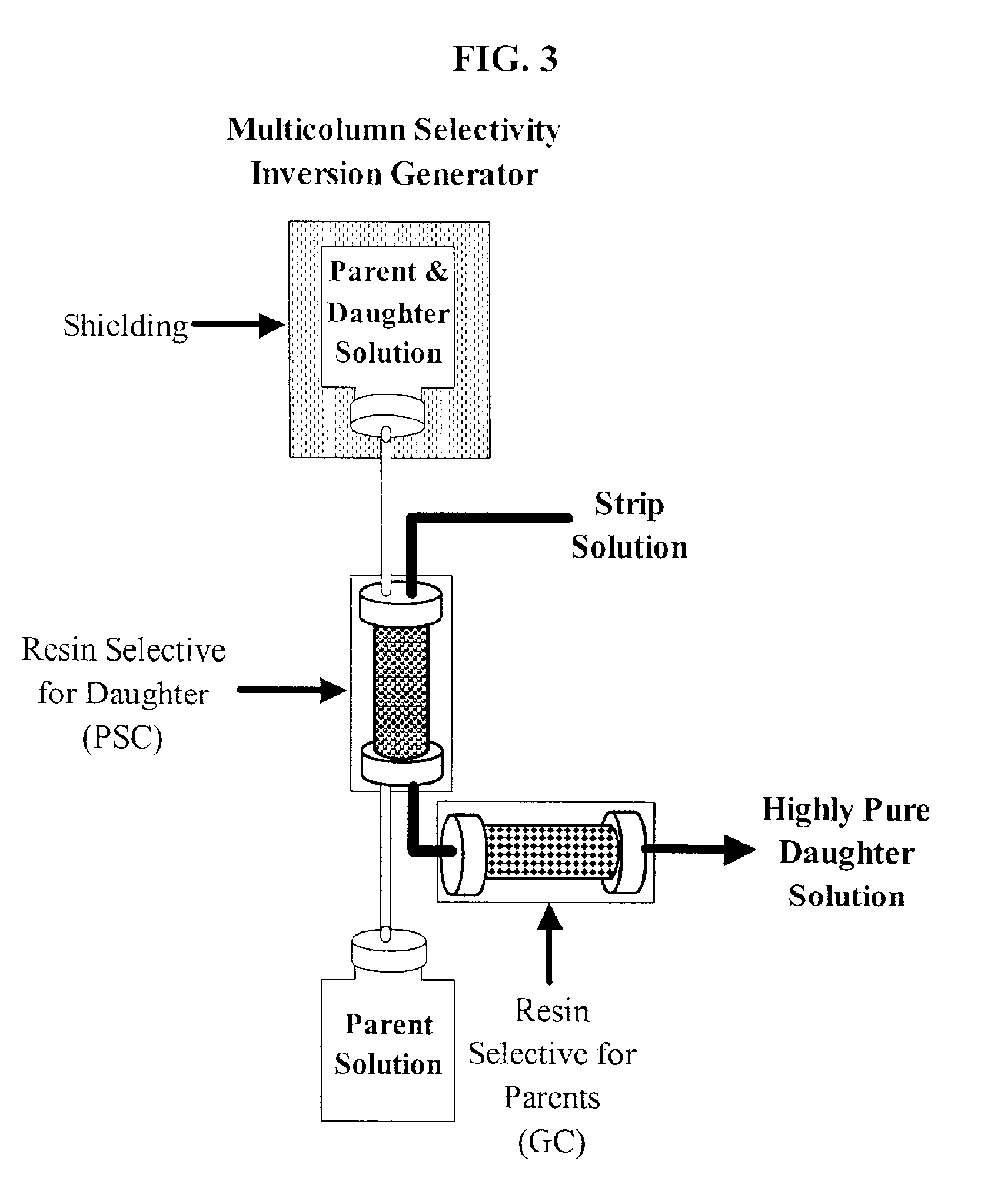Production of ultrapure bismuth-213 for use in therapeutic nuclear medicine
a technology of nuclear medicine and bismuth, which is applied in the direction of amphoteric ion exchangers, nuclear engineering, water/sewage treatment by ion exchange, etc., to achieve the effect of reducing the likelihood of parent radionuclide contamination, high separation efficiency of separation media, and more predictable separation performan
- Summary
- Abstract
- Description
- Claims
- Application Information
AI Technical Summary
Benefits of technology
Problems solved by technology
Method used
Image
Examples
example 1
Polyvalent Metal Ion Uptake by UTEVA® Resin and TOPO Resin from HCl
FIG. 4 shows the structure of dipentyl pentyl phosphonate, DAAP, which is commercially available on an extraction chromatographic material known as UTEVA® Resin. Using the Bi(III) chemistry discussed above, it was hypothesized that [H3O][BiCl4] could be extracted by the DAAP onto UTEVA® Resin and then conveniently stripped by H3O+ consumption and / or an increase in [Cl1−]. Proposed loading and stripping equilibria for a UTEVA® Resin primary separation column are presented FIG. 5.
One of several appealing aspects of the separation scheme proposed in FIG. 5 is that extraction of Ra(II) and Ac(III) by chemically pure samples of neutral organophosphorus extractants like DAAP is quite low, [see, Sekine et al., Solvent Extraction Chemistry; Marcel Dekker: New York, 1977; Schulz et al. Eds., Science and Technology of Tributyl Phosphate. Volume I, Synthesis, Properties, Reactions, and Analysis; CRC Press: Boca Raton, Fla., 198...
example 2
Separation of Polyvalent Metal Cations in HCl with UTEVA®-2 and UTEVA® Resins
The results of a chromatographic study are shown in FIG. 8 in which a mixture of 122Ba(II), 139Ce(III), and 207Bi(III), the former two as chemical analogs for Ra(II) and Ac(III), respectively, in 0.20 M HCl were eluted on UTEVA®-2 Resin (a mixture of organophosphine oxides and organophosphonates). During loading of four bed volumes (BV) of 0.20 M HCl, 133Ba(II) and 139Ce(III) elute with the first free column volume of eluate. Some 207Bi(III) was detected during loading, but was not statistically significant at less than twice background radiation levels.
After 3 BV of 0.20 M HCl rinse, the activity of all three analytes reached background levels. Stripping with 1.0 M sodium acetate (NaOAc) in 0.20 M NaCl elutes 207Bi(III) in a rather broad band, with no significant 133Ba(II) or 139Ce(III) activity. This chromatographic study displayed an approximate DF value of 213Bi(III) from 225 / 224Ra(II) and 225Ac(III) of...
example 3
Guard Column Use to Enhance DF Values
To ensure that no long-lived radionuclidic parents exit the generator system, a guard column was developed to fully realize the advantages of the multicolumn selectivity inversion generator. The extraction equilibria hypothesized in FIG. 5 for the primary separation column are supported by the results of FIGS. 4-7, which provides some insight into the solution speciation of Bi(III) and offers guidance in the selection of guard column materials and solution conditions. It is likely that Bi(III) is present during stripping as a polyanionic complex at [Cl1−] greater than 0.5 M, whereas the 225 / 224Ra(II) and 225Ac(III) impurities exist as neutral ion pairs in solution. These observations suggest that a cation-exchange resin can be used as a guard column, presuming the solution conditions can be tuned to permit elution of bismuth polyhalide anions such as BiCl52−, BiCl63−, and the like, from the cation-exchange resin while 225 / 224Ra(II) and 225Ac(III)...
PUM
| Property | Measurement | Unit |
|---|---|---|
| Molar density | aaaaa | aaaaa |
| Molar density | aaaaa | aaaaa |
| Molar density | aaaaa | aaaaa |
Abstract
Description
Claims
Application Information
 Login to View More
Login to View More - R&D
- Intellectual Property
- Life Sciences
- Materials
- Tech Scout
- Unparalleled Data Quality
- Higher Quality Content
- 60% Fewer Hallucinations
Browse by: Latest US Patents, China's latest patents, Technical Efficacy Thesaurus, Application Domain, Technology Topic, Popular Technical Reports.
© 2025 PatSnap. All rights reserved.Legal|Privacy policy|Modern Slavery Act Transparency Statement|Sitemap|About US| Contact US: help@patsnap.com



